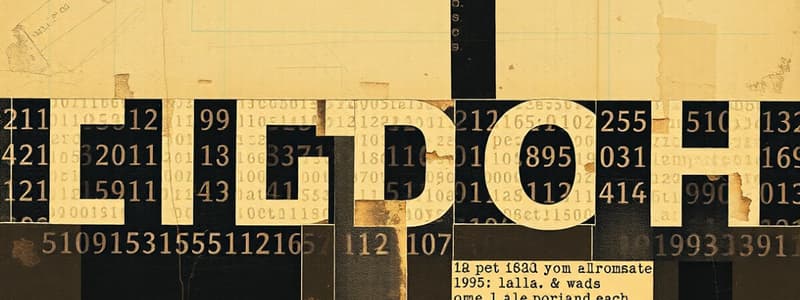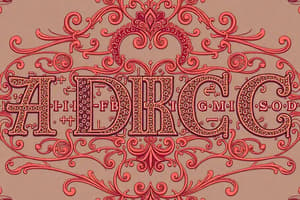Podcast
Questions and Answers
What sequence of letters consistently appears before 'QRSTUVWXQO' in the provided content?
What sequence of letters consistently appears before 'QRSTUVWXQO' in the provided content?
- AABBCC
- KLLMNO (correct)
- HIJKLMN
- XYZABC
Which of these letter sequences follows 'UVWX' in the content?
Which of these letter sequences follows 'UVWX' in the content?
- QR
- SO
- XY (correct)
- MN
Identifying patterns, which sequence follows 'NO' in the content?
Identifying patterns, which sequence follows 'NO' in the content?
- ABCD
- XYZ
- KLMN
- QRNY (correct)
What customizable variable type could 'Z[O' represent in programming terms based on the content structure?
What customizable variable type could 'Z[O' represent in programming terms based on the content structure?
Which sequence is commonly associated with 'WXY' in the content?
Which sequence is commonly associated with 'WXY' in the content?
What character precedes the distinctive sequence '$%&' in the content?
What character precedes the distinctive sequence '$%&' in the content?
Which sequence follows 'XN' in the provided content?
Which sequence follows 'XN' in the provided content?
What is the common structure that begins with 'L' in the content?
What is the common structure that begins with 'L' in the content?
What is the primary focus of the document?
What is the primary focus of the document?
Which aspect of data handling is emphasized in the document?
Which aspect of data handling is emphasized in the document?
Which component is most likely NOT mentioned in the document?
Which component is most likely NOT mentioned in the document?
What type of data representation is utilized throughout the document?
What type of data representation is utilized throughout the document?
Which of the following processes is likely described in the document?
Which of the following processes is likely described in the document?
What logical operation might be associated with the cipher techniques in the document?
What logical operation might be associated with the cipher techniques in the document?
What is likely a required resource outlined for implementing the methods described?
What is likely a required resource outlined for implementing the methods described?
Which of these outcomes is least likely to be achieved using the techniques in this document?
Which of these outcomes is least likely to be achieved using the techniques in this document?
What does the content suggest about the relationship between the variables discussed?
What does the content suggest about the relationship between the variables discussed?
Which element represents a significant factor in the equations provided?
Which element represents a significant factor in the equations provided?
In analyzing the data structure, what is indicated by the presence of multiple variables?
In analyzing the data structure, what is indicated by the presence of multiple variables?
Which aspect must be considered when interpreting the results from the provided content?
Which aspect must be considered when interpreting the results from the provided content?
What challenge does high complexity in data models pose?
What challenge does high complexity in data models pose?
What is likely hindered by the interaction of multiple factors as indicated in the data?
What is likely hindered by the interaction of multiple factors as indicated in the data?
When variables are tightly correlated, what is expected concerning their changes?
When variables are tightly correlated, what is expected concerning their changes?
What role do initial conditions play in the models discussed?
What role do initial conditions play in the models discussed?
What does the presence of multiple sequences suggest about the information structure?
What does the presence of multiple sequences suggest about the information structure?
Which aspect does the repeated mention of 'ZSSVSSkV`X' likely emphasize?
Which aspect does the repeated mention of 'ZSSVSSkV`X' likely emphasize?
How does the structure of the collections of data appear to influence interpretation?
How does the structure of the collections of data appear to influence interpretation?
What might be inferred about the relationship between the components identified as 'Z`[' and 'VXY'?
What might be inferred about the relationship between the components identified as 'Z`[' and 'VXY'?
What role might 'U\S~' have in the overall framework being discussed?
What role might 'U\S~' have in the overall framework being discussed?
Which character follows a pattern of alternating between letters and special symbols in the provided content?
Which character follows a pattern of alternating between letters and special symbols in the provided content?
Identify the sequence that does not fit into the character arrangement in the content.
Identify the sequence that does not fit into the character arrangement in the content.
What is the significance of the number sequence appearing in the content?
What is the significance of the number sequence appearing in the content?
Which option suggests a method of interpreting the characters in the content?
Which option suggests a method of interpreting the characters in the content?
What could the section 'UV^A' potentially denote in the context provided?
What could the section 'UV^A' potentially denote in the context provided?
Which option describes a recurring theme within the strings present in the content?
Which option describes a recurring theme within the strings present in the content?
What role do special characters play in the sequences given?
What role do special characters play in the sequences given?
Identify an erroneous assumption one could make about the content's structure.
Identify an erroneous assumption one could make about the content's structure.
Flashcards
What is a Unicode character?
What is a Unicode character?
A type of special symbol where a letter, number or punctuation mark is replaced by a visually similar or symbolic character.
What is Unicode?
What is Unicode?
Unicode is a standard that allows computers to represent and process text from different writing systems, including accented letters, symbols, and emojis, by assigning unique numbers to every character.
What is a glyph?
What is a glyph?
It is a way to visually represent a character, either a letter, a number, or a symbol, within a computer's memory.
What is a font?
What is a font?
Signup and view all the flashcards
What is a typeface?
What is a typeface?
Signup and view all the flashcards
What is rendering text?
What is rendering text?
Signup and view all the flashcards
What is a code page?
What is a code page?
Signup and view all the flashcards
Why is text interpretation important?
Why is text interpretation important?
Signup and view all the flashcards
Quality Assurance (QA)
Quality Assurance (QA)
Signup and view all the flashcards
Software Testing
Software Testing
Signup and view all the flashcards
Usability Testing
Usability Testing
Signup and view all the flashcards
Functional Testing
Functional Testing
Signup and view all the flashcards
Performance Testing
Performance Testing
Signup and view all the flashcards
Security Testing
Security Testing
Signup and view all the flashcards
Code Review
Code Review
Signup and view all the flashcards
Agile Software Development
Agile Software Development
Signup and view all the flashcards
Escape Sequences in Strings
Escape Sequences in Strings
Signup and view all the flashcards
Unicode
Unicode
Signup and view all the flashcards
Glyph
Glyph
Signup and view all the flashcards
Font
Font
Signup and view all the flashcards
Typeface
Typeface
Signup and view all the flashcards
Rendering Text
Rendering Text
Signup and view all the flashcards
Code Page
Code Page
Signup and view all the flashcards
Text Interpretation
Text Interpretation
Signup and view all the flashcards
What is a character set?
What is a character set?
Signup and view all the flashcards
What is text rendering?
What is text rendering?
Signup and view all the flashcards
What is quality assurance (QA)?
What is quality assurance (QA)?
Signup and view all the flashcards
Study Notes
Detailed Content Outline
- Standards, Policies, and Procedures: Ensure compliance and ethics policies exist (e.g., non-retaliation, record management, conflict of interest, privacy). Maintain these policies, consult relevant resources, and align policies with organizational mission, vision, values, and codes of conduct. Ensure policies address regulatory requirements and interactions with third parties. Document the compliance and ethics program, and address specific risk areas. Maintain compliance and ethics governance policies.
Compliance and Ethics Program Administration
- Maintain a compliance and ethics activity reporting system to internal governing bodies (e.g., board of directors, audit committee) and senior business leaders (e.g., CEO, CFO). Coordinate operational aspects with management (e.g., oversight committee). Collaborate internally and externally to implement best practices. Maintain knowledge of relevant laws and regulations. Apply laws to organizational needs; ensure credibility and integrity of program. Recognize the need for outside expertise, and ensure the governing board understands their responsibilities. Define counsel's role in the compliance and ethics process. Manage resources (financial and personnel). Integrate program into business operations. Develop an annual compliance and ethics plan.
Communication, Education, and Training
- Disseminate information on emerging risk areas; communicate compliance and ethics throughout the organization. Develop targeted training (risk-specific, orientation, remedial). Evaluate the effectiveness of training. Ensure employees are aware of obligations to report misconduct, and their job-specific compliance and ethics responsibilities. Promote a culture of compliance and ethics. Ensure compliance and ethics personnel participate in ongoing professional development. Track training participation. Ensure compliance and ethics training for board members, employees, vendors, and other agents. Train responders to compliance/ethics inquiries. Manage training delivery.
Monitoring, Auditing, and Internal Reporting Systems
- Protect anonymity and confidentiality in reporting systems; publicize the reporting system. Monitor for organizational misconduct (e.g., legal, regulatory, policy violations) and ensure systems enable employees, vendors, and third-parties to report and seek advice. Assure responses to reported concerns and compliance-related activities are monitored. Analyze audit results (e.g., track, evaluate, benchmark) to address any issues arising from external audits and internal compliance/ethics audits. Evaluate the effectiveness of the program on an ongoing basis.
Investigation and Response, Discipline, and Incentives
- Ensure discipline proportional to violations and consistent across the organization. Document recommended disciplinary actions. Encourage compliant and ethical behavior; recommend incorporating compliance and ethical metrics into performance evaluations. Assure compliance with non-retaliation policies. Report validated instances of noncompliance internally. Develop and track corrective action plans. Engage qualified resources for investigation needs. Respond to internal or governmental inquiries and investigations. Coordinate investigations involving privileged information to maintain relevant privacy (e.g., attorney-client privilege.) Participate in misconduct prevention system development.
Risk Assessment
- Secure a scalable and timely risk assessment methodology. Conduct periodic compliance and ethics risk assessments across the organization; integrate risk assessment into various business units. Prioritize organizational compliance risks. Ensure management action plans are developed and executed based on assessment findings. Communicate risk assessment findings to management and the board. Ensure due diligence is performed on third parties, as well as management involvement in the process.
Studying That Suits You
Use AI to generate personalized quizzes and flashcards to suit your learning preferences.




